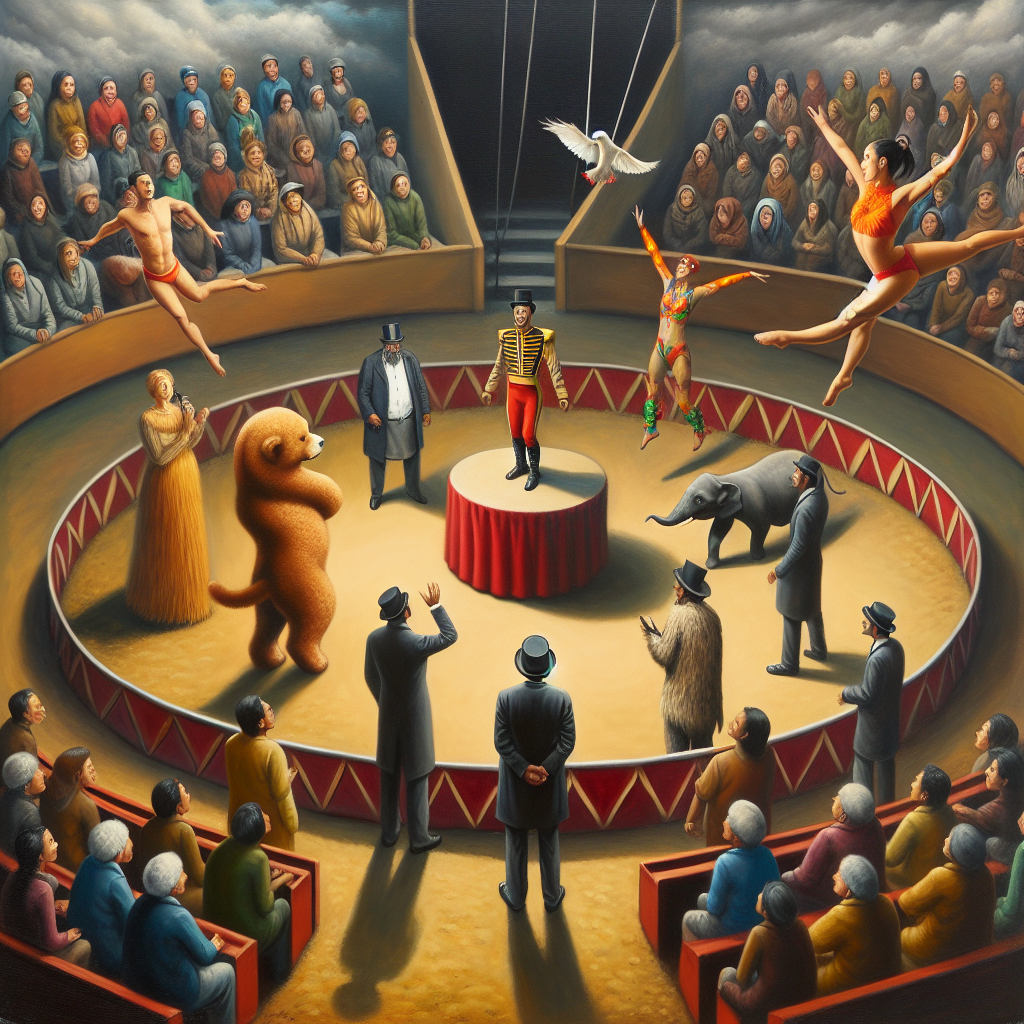In today’s ever-evolving society, the ethical implications of animal performances and entertainment have become a subject of great importance. As individuals, we are faced with the responsibility to question the ethics behind these practices and consider the impact they have on the animals involved. This article explores the complexities surrounding the ethics of animal performances and entertainment, encouraging readers to reflect on their role in promoting the well-being and dignity of these magnificent creatures.

The Psychological and Physical Well-being of Animals
The impact of captivity on animals
When it comes to animals in captivity, there are undeniable concerns about their psychological and physical well-being. Being confined to small spaces and being separated from their natural habitats and social structures can have a significant impact on animals. Studies have shown that animals in captivity exhibit signs of stress, anxiety, and even depression. They may engage in repetitive behaviors or self-harm as a result of the psychological distress caused by confinement. It is crucial for us to understand and address these negative consequences to ensure the well-being of animals.
The physical effects of performing on animals
Animal performances, such as those in circuses or marine parks, often involve physically demanding tricks and behaviors. These performances can take a toll on the animals’ bodies, leading to various health problems. Many animals used in performances suffer from injuries related to the unnatural movements and activities they are forced to perform. Additionally, the training methods used to teach these behaviors may involve physical coercion or punishment, leading to further physical stress and potential long-term damage. It is essential to consider the physical impact of these performances on animals and prioritize their health and well-being.
The role of enrichment and stimulation in animal welfare
Providing animals with proper enrichment and stimulation is fundamental to their overall well-being while in captivity. Enrichment can include a variety of activities and stimuli designed to stimulate the animals’ natural behaviors, such as foraging, exploring, and problem-solving. Without adequate mental and physical stimulation, animals in captivity may become bored, frustrated, and develop abnormal behaviors. By implementing enrichment programs, we can help alleviate the negative effects of captivity and improve the psychological health of these animals. It is our responsibility to ensure their well-being by providing them with an environment that supports their natural instincts and behaviors.
The Conservation and Preservation of Species
The importance of preserving endangered species
Preserving endangered species is not only crucial for the animals themselves but also for the ecological balance of our planet. Every species plays a vital role in maintaining a healthy ecosystem, and the loss of any species can have far-reaching consequences. By preserving endangered species, we are ensuring the preservation of biodiversity and all the benefits it brings. It is our moral obligation to protect these animals and their habitats, as they hold immense value not only in their own right but also for future generations.
The role of animal performances in conservation efforts
Animal performances have been marketed as a form of education and conservation, with the aim of raising awareness about endangered species and their conservation needs. While these performances may attract large audiences and generate funds for conservation initiatives, it is crucial to critically assess their true impact. Are these performances truly successful in imparting meaningful knowledge and inspiring long-term conservation efforts? It is essential to establish clear and measurable goals for any conservation program associated with animal performances and evaluate their effectiveness. We must prioritize the well-being of animals and ensure that their use in performances goes hand in hand with genuine conservation efforts.
The ethics of breeding animals for entertainment purposes
Breeding animals solely for the purpose of entertainment raises ethical concerns. The practice of selectively breeding animals for specific physical traits or behaviors required for performances can lead to genetic abnormalities and health issues. In some cases, animals subjected to breeding programs may suffer from inbreeding and reduced genetic diversity. Ensuring the welfare of these animals should be a priority, and breeding practices should focus on conservation, not exploitation. It is necessary to reevaluate the ethics of breeding animals for entertainment purposes and promote responsible breeding practices that prioritize the well-being and genetic diversity of the species.
The Use of Force and Coercion in Animal Training
The ethics of using punishment in training
The use of force or coercion in animal training raises ethical questions regarding the treatment of animals. Punitive training methods, such as hitting, whipping, or electric shock devices, are not only cruel but also ineffective in the long term. These methods may result in fear, distress, and even physical harm to animals. It is essential to recognize that positive reinforcement and reward-based training methods have been proven to be more effective, humane, and respectful of the animals’ well-being. We must prioritize ethical training practices that promote trust, cooperation, and positive experiences for the animals.
The impact of training methods on animal welfare
Training methods used in animal performances can have a significant impact on the welfare of the animals involved. Coercive training techniques that rely on punishment and force can lead to stress, fear, and anxiety in animals. Animals subjected to such methods may suffer from long-term psychological and physical damage. In contrast, positive reinforcement-based training techniques prioritize the well-being of animals by focusing on encouraging desired behaviors and avoiding punishment. By adopting ethical training methods, we can ensure the welfare of animals involved in performances and create a positive experience for both the animals and the audience.
Alternatives to coercive training techniques
With a growing understanding of animal welfare and ethical concerns, there is a need for alternative training techniques that prioritize positive reinforcement and minimize the use of coercion. Training methods such as clicker training, target training, and shaping behavior through positive rewards have shown promising results. These techniques rely on understanding the animal’s natural behaviors and reinforcing desired behaviors through positive associations. By embracing these alternative training methods, we can promote humane practices that respect the well-being of the animals and cultivate positive relationships between humans and animals.
The Impact on Animal Social Structures
The disruption of natural social dynamics
Animals in captivity often experience a significant disruption in their natural social dynamics. Many species have complex social structures and rely on social interactions for their psychological well-being. When animals are housed in artificial environments or separated from their social groups, they may experience social isolation, stress, and behavioral issues. It is crucial to consider the impact of captivity on animals’ social lives and seek ways to maintain or replicate their natural social structures to promote their well-being.
The effect of separation from natural habitats and groups
Separation from their natural habitats and social groups can have profound effects on animals. Many species are highly adapted to their specific environments and have specific social roles and behaviors within their groups. When animals are removed from their natural habitats or groups, they may struggle to adapt and may exhibit signs of distress, agitation, or depression. Efforts should be made to minimize the separation of animals from their natural habitats and groups as much as possible to ensure their psychological well-being.
The role of human-animal interactions in socialization
Human-animal interactions can play a crucial role in mitigating the negative impact of captivity on animals’ social lives. By providing positive and enriching interactions with humans, animals can experience a form of socialization that may help alleviate the effects of social isolation. However, it is essential to ensure that these interactions are respectful of the animals’ natural behaviors and needs. Developing programs that foster meaningful and positive interactions between humans and animals can contribute to the well-being and socialization of captive animals.

The Ethics of Exploitation and Human Enjoyment
The commercialization of animal performances
Animal performances have become a significant source of entertainment and revenue, leading to the commercialization of animals as commodities. Animals are often treated as mere props for human enjoyment without proper consideration for their well-being. It is essential to question the ethics of such commercialization and ensure that the primary focus remains on the welfare and protection of the animals rather than financial gain.
The balance between entertainment value and animal welfare
A delicate balance must be struck between providing entertainment value and ensuring the welfare of the animals involved. It is essential to evaluate whether the performances truly provide enrichment and quality of life for the animals or if they exploit them for human enjoyment. Implementing strict welfare standards and continuously monitoring the animals’ well-being can help maintain this balance and prevent the exploitation of animals for entertainment purposes.
The responsibility of humans in ensuring ethical treatment
As guardians of the planet and its inhabitants, humans have a responsibility to ensure ethical treatment and preservation of all species. It is crucial for individuals, organizations, and governments to take accountability for the ethical treatment of animals involved in performances and entertainment. By advocating for humane practices and raising awareness about the impact of animal performances, we can promote a culture of empathy and compassion towards animals and help ensure their ethical treatment.
The Regulation and Oversight of Animal Performances
Existing laws and regulations
Numerous countries have established laws and regulations to govern the treatment of animals involved in performances and entertainment. These laws aim to ensure the welfare and protection of these animals, setting standards for their housing, care, and training. It is essential for these existing laws to be effectively enforced and for individuals and organizations to comply with them to prevent the mistreatment of animals.
The effectiveness of enforcement and monitoring
Even with existing laws in place, there is a need for robust enforcement and monitoring mechanisms to ensure compliance and detect any potential violations. Government agencies, animal welfare organizations, and the public should actively participate in monitoring animal performances and reporting any concerns. By holding individuals and organizations accountable for their actions, we can promote ethical practices and prevent the exploitation of animals.
The need for stricter guidelines and accountability
While existing laws and regulations provide a foundation for the protection of animals, there is still room for improvement. Stricter guidelines and regulations should be established to address potential loopholes and ensure the comprehensive welfare of animals involved in performances. Additionally, increased accountability and transparency from organizations involved in animal performances can help build public trust and ensure ethical treatment practices are followed.
The Evolving Attitudes Towards Animal Entertainment
Growing public concern for animal welfare
In recent years, there has been a notable increase in public concern for animal welfare, particularly regarding their use in entertainment. Society is increasingly questioning the ethics of using animals for our amusement and demanding more humane treatment. This shift in public attitudes reflects a growing empathy towards animals and a recognition of their rights to a life free from exploitation. It is essential for this concern to be heard and acted upon by individuals, organizations, and policymakers to drive meaningful change.
Changing perceptions of animal sentience and rights
Scientific research and growing awareness have led to a change in our perception of animals’ cognitive abilities and capacity for emotions. We now understand that animals are sentient beings capable of experiencing pleasure, pain, and complex emotions. This recognition has sparked a reassessment of their rights and treatment in various contexts, including entertainment. It is crucial for society to recognize and respect the inherent value and rights of animals, ensuring that they are treated ethically and with dignity.
The influence of activism and public opinion on ethical considerations
Animal rights activism and public opinion have played a significant role in driving ethical considerations within the entertainment industry. Activist campaigns, social media movements, and public protests have helped shed light on the plight of animals used in performances, raising awareness and stimulating a dialogue around their ethical treatment. Influenced by public opinion, many companies and organizations have made changes to their practices to align with ethical standards. This collective voice of activism and public opinion is fundamental in transforming the entertainment industry to one that prioritizes animal welfare.
The Alternatives to Animal Performances
Promotion of educational experiences
Educational experiences can offer a more ethical alternative to conventional animal performances. Zoos, wildlife sanctuaries, and educational institutions can focus on providing informative and interactive experiences where visitors can learn about animals and their habitats in a responsible manner. Emphasizing conservation efforts, environmental stewardship, and promoting respect for animals, these educational experiences can offer insights into the natural world without exploiting or compromising the welfare of animals.
The rise of technology as a substitute
Technological advancements have opened up new possibilities to simulate animal experiences without the use of live animals. Virtual reality and augmented reality experiences can transport individuals into immersive environments where they can interact with and learn about different species. Using technology as a substitute for live animal performances can offer a more ethical and sustainable form of entertainment that inspires curiosity and conservation awareness.
Encouraging conservation-focused tourism
Conservation-focused tourism provides an opportunity for individuals to observe animals in their natural habitats while supporting conservation efforts. By engaging in responsible and sustainable wildlife tourism, individuals can contribute to the protection of endangered species and their habitats. Such tourism activities prioritize the well-being of animals and ecosystem conservation, offering an ethical alternative to animal performances where animals are able to live freely and exhibit their natural behaviors.
The Role of Education and Awareness
Teaching empathy and ethics from an early age
Education plays a pivotal role in shaping attitudes and fostering empathy towards animals. By incorporating animal welfare and ethical considerations into curricula from an early age, we can instill a sense of responsibility and compassion in future generations. Encouraging students to understand the impact of human actions on animals and the environment will help create a more empathetic and animal-friendly society.
The responsibility of educational institutions and zoos
Educational institutions and zoos have a unique responsibility to promote ethical treatment and conservation efforts. Zoos can serve as educational platforms, focusing on providing visitors with accurate information about animals and their habitats while emphasizing the importance of conservation. By partnering with educational institutions and working together towards the common goal of ethical treatment and conservation, we can ensure that future generations have a deeper understanding of the importance of respecting and preserving animal welfare.
Engaging the public in conservation efforts
Public engagement is crucial in securing the future of animal welfare and conservation. From awareness campaigns to volunteer programs, engaging the public in conservation efforts can create a groundswell of support for ethical treatment and preservation of animals. By involving the public in hands-on experiences, such as volunteering at wildlife rescue centers or participating in citizen science projects, we can foster a sense of ownership and stewardship towards animals and their habitats.
The Future of Animal Performances
Exploring sustainable and ethical entertainment options
The future of animal performances lies in exploring sustainable and ethical entertainment options. Fostering a shift towards performance formats that prioritize animal welfare and conservation will safeguard the well-being of animals while still providing meaningful experiences for audiences. Innovative approaches, such as using animatronics or multimedia presentations, can create immersive and educational entertainment that does not compromise the welfare of live animals.
The potential risks and benefits of phasing out animal performances
Phasing out animal performances raises both risks and benefits. While the immediate impact on certain industries and economies may be challenging, there is an opportunity for positive change. The risks can be mitigated by offering alternative career paths and retraining programs for individuals relying on animal performances for their livelihoods. The benefits of phasing out animal performances include improved animal welfare, a shift towards more ethical entertainment options, and the promotion of conservation-focused initiatives. It is crucial to carefully consider and plan for the potential risks and benefits to ensure a smooth transition towards a more ethical future.
Collaboration between stakeholders for a more ethical future
Achieving a more ethical future for animal performances requires collaboration between stakeholders, including animal welfare organizations, governments, educational institutions, and the entertainment industry. By fostering dialogue, sharing best practices, and working together towards common goals, we can create a unified approach to animal welfare and push for meaningful change. Collaboration ensures that the voices of all stakeholders are heard and that comprehensive solutions are developed for a more ethical future.
In conclusion, the ethical considerations surrounding animal performances and entertainment are complex and multifaceted. We must recognize and address the psychological and physical impacts of captivity, advocate for the conservation and preservation of species, reconsider training methods, acknowledge the impact on animal social structures, and strike a balance between exploitation and human enjoyment. With heightened awareness and evolving attitudes, alternative forms of entertainment, and a commitment to education and conservation, we can shape a future where animals are treated ethically and their well-being is prioritized. It is our collective responsibility to ensure a more compassionate and sustainable approach to animal performances.

